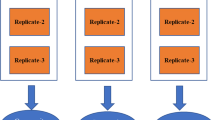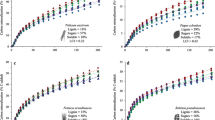Abstract
Soil microflora can directly take up the amino acids (Aas) released by decomposing plants and use them, together with de novo synthesized Aas, as building blocks for their own structures, which are expected to have an Aa composition that differs from plant-derived structures. The degree of change in the Aa composition during OM decomposition should reflect the degree of N evolution. Here we apply this concept to the study of three litter decomposition sequences in European forests: boreal (Pinus sylvestris L., Jädraås, Sweden), cool Atlantic (Pinus sylvestris L., La Gileppe, Belgium), and warm Atlantic (Pinus pinaster L., Montemor, Portugal). Litter was sorted into six decomposition stages according to morphological features: from intact, light-brown needles to dark needle fragments with faunal perforations. At each stage, the Aa composition of the litter was studied by acid hydrolysis plus liquid chromatography of the hydrolysates. Both the Aa content of the litter and the unhydrolyzable/total OC ratio increased with decomposition, but this was not the case with the unhydrolyzable/total N ratio. There is no sole pattern of Aa change with decomposition: in Jädraås and Montemor most of the changes occur in the initial and final steps, while in La Gileppe the changes seem quite evenly spread throughout the decomposition. The fact that the Aa composition of the litter did not converge with decomposition suggests the existence of site-specific biotas with contrasted Aa fingerprints. The abundance of a given Aa relative to the total differed among Aas and sites; but for some Aas it was possible to detect common patterns of decomposition behaviour (either a consistent increase or a consistent decrease). The aa/total ratio for Gly, Ala and Thr consistently increased with decomposition. These Aas were used to search for a numerical index, the Aa signature (AaSIG), which would reflect the changes in Aa composition from fresh debris to highly decomposed organic materials. The change in the proposed AaSIG was found to correlate well with the mathematical distance from the starting point (calculated as the euclidean distance); this suggests that it could be potentially useful as an indicator of N evolution during litter decomposition, at least in its first stages.









Similar content being viewed by others
Abbreviations
- Aa:
-
amino acid
- AaSIG :
-
amino acid signature
- OM:
-
organic matter
References
Amelung W (2001) Methods using amino sugars as markers for microbial residues in soil. In: Lal R, Kimble JM, Follett RF, Stewart BA (eds) Assessment methods for soil carbon pools. Adv Soil Sci, CRC/Lewis, Boca Raton, pp 233–270
Amelung W (2003) Nitrogen biomarkers and their fate in soil. J Plant Nutr Soil Sci 166:677–686
Amelung W, Zhang X (2001) Determination of amino acid enantiomers in soils. Soil Biol Biochem 33:553–562
Beavis J, Mott CJB (1996) Effects of land use on the amino acid composition of soils. 1. Manured and unmanured soils from the Broadbalk continuous wheat experiment, Rothamsted, England. Geoderma 72:259–270
Beavis J, Mott CJB (1999) Effects of land use on the amino acid composition of soils. 2. Soils from the Park Grass experiment and Broadbalk Wilderness, Rothamsted, England. Geoderma 91:173–190
Berg B, Laskowski R (2006) Litter decomposition: a guide to carbon and nutrient turnover. Academic, Burlington, MA, USA
Berg B, McClaugherty C (1987) Nitrogen release from litter in relation to the disappearance of lignin. Biogeochemistry 4:219–224
Berg B, Berg MP, Bottner P, Box E, Breymeyer A, Calvo de Anta R, Coûteaux MM, Escudero A, Gallardo A, Kratz W, Madeira M, Malkönen E, McClaugherty C, Meentemeyer V, Muñoz F, Piussi P, Remacle J, Virzo de Santo A (1993) Litter mass loss rates in pine forests of Europe and Eastern United States: some relationships with climate and litter quality. Biogeochemistry 20:127–159
Berg B, Albrektson A, Berg MP, Cortina J, Johansson MB, Gallardo A, Madeira M, Pausas J, Kratz W, Vallejo R, McClaugherty C (1999) Amounts of litter fall in some pine forests in a European transect, in particular Scots pine. Ann For Sci 56:625–639
Bottner P, Coûteaux MM, Anderson JM, Berg B, Billès G, Bolger T, Casabianca H, Romanyà J, Rovira P (2000) Decomposition of 13C-labelled plant material in a european 65–40 degrees latitudinal transect of coniferous forest soils: simulation of climate change by translocation of soils. Soil Biol Biochem 32:527–543
Camargo FAdO, Gianello C, Vidor C (1997) Comparative study of five hydrolytic methods in the determination of soil organic nitrogen compounds. Commun Soil Sci Plant Anal 28:1303–1309
Coûteaux MM, Bottner P, Anderson JM, Berg B, Bolger T, Casals P, Romanyà J, Thiéry JM, Vallejo VR (2001) Decomposition of 13C-labelled standard plant material in a latitudinal transect of European coniferous forests: differential impact of climate on the decomposition of soil organic matter compartments. Biogeochemistry 54:147–170
Cuadras CM (1982) Métodos de análisis multivariante. Eunibar, Barcelona
De Groot PWJ, Ram AF, Klis FM (2005) Review: features and functions of covalently linked proteins in fungal cell walls. Fungal Gen Biol 42:657–675
FAO, ISRC, ISSS (1998) World reference base for soil resources. 84 World Soil Resources Reports. FAO, Rome
González-Prieto SJ, Carballas T (1988) Modified method for the fractionation of soil organic nitrogen by successive hydrolyses. Soil Biol Biochem 20:1–6
Gourbière F (1981) Vie, sénescence et décomposition des auiguilles de sapin (Abies alba Mill.). I. Méthodologie et premiers résultats. Acta Oecol Oecol Plant 2:223–232
Harrack H, Chamberland H, Plante M, Bellemare G (1999) A proline-, threonine-, and glycine-rich protein down-regulated by drought is localized in the cell wall of xylem elements. Plant Physiol 121:557–564
Hendrickson OQ (1985) Variation in the C:N of substrate mineralized during forest humus decomposition. Soil Biol Biochem 17:435–440
Janel P, Monrozier LJ, Toutain F (1979) Characterization of nitrogen in litter and soil by acid hydrolysis. Soil Biol Biochem 11:141–146
Keller B, Sauer N, Lamb CJ (1988) Glycine-rich cell wall proteins in bean: gene structure and association of the protein with the vascular system. EMBO J 7:3625–3633
Kelley KR, Stevenson FJ (1996) Organic forms of N in soil. In: Piccolo A (ed) Humic substances in terrestrial ecosystems. Elsevier, Amsterdam, pp 407–427
Kimber RWL, Nannipieri P, Ceccanti B (1990) The degree of racemization of amino acids released by hydrolysis of humic-protein complexes: implications for age assessment. Soil Biol Biochem 22:181–185
Knicker H (2004) Stabilization of N-compounds in soil and organic-matter-rich sediments – what is the difference? Mar Chem 92:167–195
Knicker H, Lüdemann HD, Haider K (1997) Incorporation studies of \({\text{NH}}_4^ + \) during incubation of organic residues by 15N-CPMAS-NMR spectroscopy. Eur J Soil Sci 48:431–441
Koch AL (2007) The bacteria: their origin, structure, function and antibiosis. Springer, Dordrecht, The Netherlands
Kurz C, Coûteaux MM, Thiéry JM (2000) Residence time and decomposition rate of Pinus pinaster needles in the forest floor from direct field measurements under a Mediterranean climate. Soil Biol Biochem 32:1197–1206
Kurz-Besson C (2000) Décomposition de litières de pin, Pinus sylvestris, P. halepensis et P. pinaster, dans un transect climatique éuropéen: Rôle de la qualité des litières et du climat. Thèse de Doctorat, Univ Paris-Sud, UFR Scientifique d’Orsay
Kurz-Besson C, Coûteaux MM, Thiéry JM, Berg B, Remacle J (2005) A comparison of litterbag and direct observation methods of Scots pine needle decomposition measurement. Soil Biol Biochem 37:2315–2318
Kurz-Besson C, Coûteaux MM, Berg B, Remacle J, Ribeiro C, Romanyà J, Thiéry JM (2006) A climate response function explaining most of the variation of the forest floor needle mass and the needle litter mass loss in pine forests across Europe. Plant Soil 285:97–114
Lähdesmäki P, Piispanen R (1989) Changes in concentrations of free amino acids during humification of spruce and aspen leaf litter. Soil Biol Biochem 21:975–978
Leinweber P, Schulten HR (2000) Nonhydrolyzable forms of soil organic nitrogen: extractability and composition. J Plant Nutr Soil Sci-Z Pflanzenernähr Bodenk 163:433–439
Lowe LE (1973) Amino acid distribution in forest humus layers in British Columbia. Soil Sci Soc Amer Proc 37:569–572
McCulley RL, Burke IC (2004) Microbial community composition across the Great Plains: landscape versus regional variability. Soil Sci Soc Am J 68:106–115
McGill WB, Cole CV (1981) Comparative aspects of cycling of organic C, N, S and P through soil organic matter. Geoderma 26:267–286
McTiernan KB, Coûteaux MM, Berg B, Berg MP, Calvo de Anta R, Gallardo A, Kratz W, Piussi P, Remacle J, Virzo de Santo A (2003) Changes in chemical composition of Pinus sylvestris needle litter during decomposition along an European coniferous forest climatic transect. Soil Biol Biochem 35:801–812
Moore S, Spackman DH, Stein WH (1958) Chromatography of amino acids on sulphonated polystyrene resins. Anal Chem 30:1185–1190
Neter J, Wasserman W, Kutner MH (1990) Applied linear statistical models, 3rd edn. Irwin, Homewood, IL, USA
Roca MC, Rovira P (1989) Descomposición de hojarasca en tres ecosistemas forestales del Moncayo [Litter decomposition in three forest ecosystems of the Moncayo mountain]. Turiaso IX:373–384
Rovira P, Vallejo VR (2000) Evaluating thermal, acid hydrolysis methods as indicators of soil OM quality. Commun Soil Sci Plant Anal 31:81–100
Rovira P, Hernàndez P, Coûteaux MM, Vallejo VR (2005) Changes in the amino acid composition of decomposing plant materials in soil: species and depth effects. Commun Soil Sci Plant Anal 36:2933–2950
Ryser U, Keller B (1992) Ultrastructural localization of a bean glycine-rich protein in unlignified primary wall of protoxylem cells. Plant Cell 4:773–783
Santrucková H, Bird MI, Kalaschnikov YN, Grund M, Elhottova D, Simek M, Grigoryev S, Gleixner G, Arneth A, Schulze ED, Lloyd J (2003) Microbial characteristics of soils on a latitudinal transect in Siberia. Global Change Biol 9:1106–1117
Schulten HR, Schnitzer M (1998) The chemistry of soil organic nitrogen: a review. Biol Fertil Soils 26:1–15
Shimoi H, Kitagaki H, Ohmori H, Iimura Y, Ito K (1998) Sed1p is a major cell wall protein of Saccharomyces cerevisiae in the stationary phase and is involved in lytic enzyme resistance. J Bacteriol 180:3381–3387
Stanier RY, Doudoroff M, Adelberg EA (1977) Microbiología. Aguilar, Madrid (translated from The Microbial World, 3d edn. Prentice Hall)
Stevenson FJ (1982) Humus chemistry. Wiley & Sons, New York
Virzo de Santo A, Berg B, Rutigliano FA, Alfani A, Fioretto A (1993) Factors regulating early-stage decomposition of needle litters in five different coniferous forests. Soil Biol Biochem 25:1423–1433
Vitousek P, Hobbie S (2000) Heterotrophic nitrogen fixation in decomposing litter: patterns and regulation. Ecology 81:2366–2376
Voet D, Voet JG (1995) Biochemistry. Wiley & Sons, New York
Weber A, Sundman V (1986) Nitrogen fixation in coniferous bark litter. Plant Soil 90:419–425
Woitchik AF, Ohowa B, Kazungu JM, Rao RG, Goeyens L, Dehairs F (1997) Nitrogen enrichment during decomposition of mangrove leaf litter in an east African coastal lagoon (Kenya): relative importance of biological nitrogen fixation. Biogeochemistry 39:15–35
Yonebayashi K, Hattori T (1980) Improvements in the method for fractional determination of soil organic nitrogen. Soil Sci Plant Nutr 26:469–481
Yu LX, Chamberland H, Lafontain JG, Tabaeizadeh Z (1996) Negative regulation of gene expression of a novel proline-, threonine-, and glycine-rich protein by water stress in Lycopersicon chilense. Genome 39:1185–1193
Yu Z, Zhang Q, Kraus TEC, Dahlgren RA, Anastasio C, Zasoski RJ (2002) Contribution of amino compounds to dissolved organic nitrogen in forest soils. Biogeochemistry 61:173–198
Acknowledgements
Part of this work was funded by the Generalitat de Catalunya, through the PICS project PIC004 (Generalitat de Catalunya-CNRS joint programme), which financed the analytical work, and the AIRE programme (mobility of researchers within the Pyrenean Work Community), which financed Pere Rovira’s stay in the CNRS for the final data elaboration. The collaboration of Luis López-Sangil in the analytical work is also greatly acknowledged.
Author information
Authors and Affiliations
Corresponding author
Additional information
Responsible Editor: Barbara Wick.
Rights and permissions
About this article
Cite this article
Rovira, P., Kurz-Besson, C., Hernàndez, P. et al. Searching for an indicator of N evolution during organic matter decomposition based on amino acids behaviour: a study on litter layers of pine forests. Plant Soil 307, 149–166 (2008). https://doi.org/10.1007/s11104-008-9592-6
Received:
Accepted:
Published:
Issue Date:
DOI: https://doi.org/10.1007/s11104-008-9592-6




